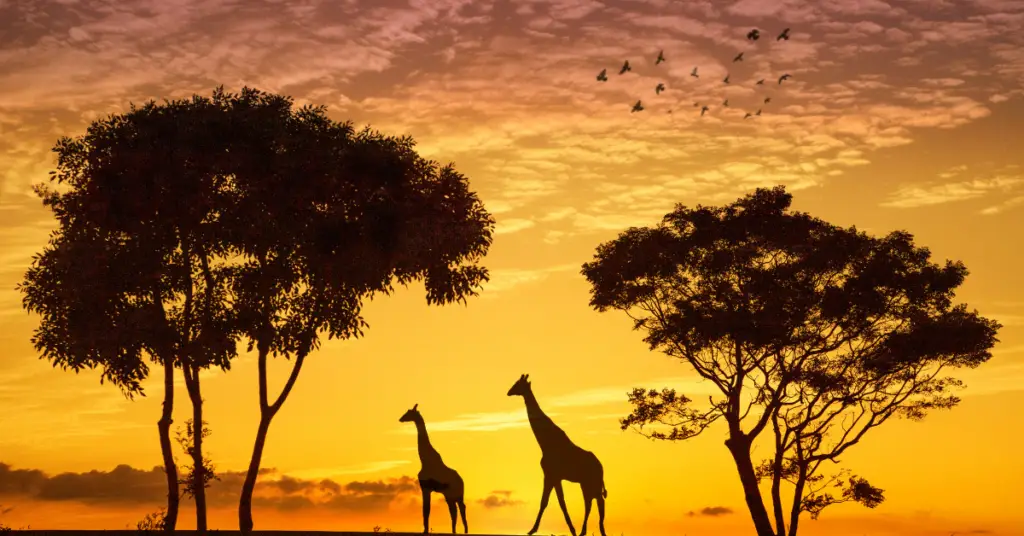Giraffe habitat is generally associated with the Acacia, Commiphora and Combretum savannahs. Appearing marginally in miombo Brachystegia woodland, while an isolated population (G. c. thornicrofti) occurs in the Luangwa Valley (where Acacia and Combretum are widespread), and in the Isoberlina woodland in Cameroon.
Giraffes are absent from true deserts and rainforests; they are also absent from the coast savannas and large savanna mosaics (such as Lopé, in Gabon). However, in the northwest of Namibia, they reside throughout the northern Namib Desert, where annual rainfall is less than 100 mm; here, they are amongst the best-adapted ungulates in this desert environment,
Giraffes in northern Namib, live in a habitat where the desert is covered with riparian forests along the banks of ephemeral rivers, which include species of Acacia, Combretum, Commiphora, Faidherbia, and surrounded by open gravel plains and sand dunes.
East of the Nile, in S. Sudan, Giraffes are never found in the permanently flooded areas of Sudan, but aerial surveys showed that they were widely distributed over the entire floodplain throughout the year. During the height of the flood season, Giraffes were relatively few in the better-drained woodlands yet, paradoxically, for Giraffes at this time was vegetation growing on large termite mounds, which are exceptionally numerous during periods of seasonal prairie flooding and provide islands of land above the surrounding floodwaters, climbers, such as Ipomea, the foliage of Balanites, Acacia, Cassia, Grewia, and the Ziziphus trees are all in a state of active growth.
Frost, combined with wind and rain, can kill giraffes; however, they can tolerate temperatures above 40°C. Spatial, weather factors, e.g. rainfall, affect their distribution as well and do influence their seasonal movements.
In Niger, Giraffes aggregate during the rainy season when fodder resources are limited, while in East Africa, they commonly disperse during the wet season, aggregating near rivers in the dry season.
Total population estimates are around 140,000 animals, mostly in areas dominated by acacia woodland and shrublands, including 3,500 Niger and Kordofan Giraffes (peralta and antiquorum combined), approximately 500 Rothschild giraffes – 36,000 reticulated giraffes, – 60,000, Masai Giraffes, 1,200 Thornicroft’s Giraffes (more numerous than at any time during the last 50 years) and more than 40,000 Angolan and Southern Giraffes (Most recent estimates of put the total population at less than 100,000animals.
The population in Niger has since increased. Giraffes can live in densities of up to 2.6/km2. Within its range, giraffe densities can vary between populations with 0.7/sq km observed in the Kruger N.P. and 0.85/sq km in Lake Manyara N.P.
On the other hand, where the abundance of quality forage is scarce, densities are much lower: for example, in southern N. P. in Sudan, where probably the giraffes no longer occur, the population density was estimated at 0.05/sq km (0.03–0.1/km2 ) and in Tsavo East N. P. at 0.2/km2. The lowest densities have been recorded in the desert-dwelling populations of Niger and Namibia (0.01/km2).

Erzsebet Frey (Eli Frey) is an ecologist and online entrepreneur with a Master of Science in Ecology from the University of Belgrade. Originally from Serbia, she has lived in Sri Lanka since 2017. Eli has worked internationally in countries like Oman, Brazil, Germany, and Sri Lanka. In 2018, she expanded into SEO and blogging, completing courses from UC Davis and Edinburgh. Eli has founded multiple websites focused on biology, ecology, environmental science, sustainable and simple living, and outdoor activities. She enjoys creating nature and simple living videos on YouTube and participates in speleology, diving, and hiking.

